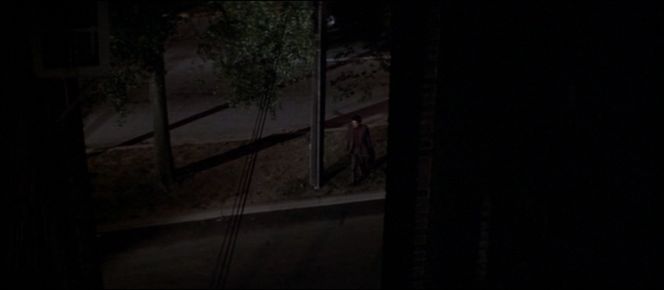 Back to selection
Back to selection
The Blue Velvet Project
Blue Velvet, 47 seconds at a time by Nicholas Rombes
The Blue Velvet Project, #141

Second #6627, 110:27
In one of Blue Velvet’s most unsettling moments, Jeffrey, on his way out of Dorothy’s carnaged apartment, sees the Well-Dressed Man coming towards the building in the night. Like some figure from a dream, he approaches, his police radio crackling. At this point, neither Jeffrey nor the audience knows, at least with any certainty, that the Well-Dressed Man is in fact Frank. In his essay “The Uncanny” (1919) Freud wrote that
it is only this factor of involuntary repetition which surrounds with an uncanny atmosphere what would otherwise be innocent enough, and forces upon us the idea of something fateful and inescapable where otherwise we would have spoken of ‘chance’ only.
For it is not the simple presence (a chance encounter; a crossing of paths) of the Well-Dressed Man that’s so disturbing, but rather that the final, fatal meeting between he and Jeffrey seems, as Freud would say, fateful and inescapable. In the dark, in the night, here he comes, a monster disguised as a human being. In a few moments he will tear off his fake moustache, just as Dorothy pulled off her wig earlier. In truth, Frank’s disguise is a double illusion: Dennis Hopper playing the part of Frank, and Frank playing the part of the Well-Dressed Man. When he takes off his costume in Dorothy’s apartment, where Jeffrey will be hiding, he does so only to reveal another costume, the one that Hopper wears to play Frank. This is the way of Hollywood, the dream factory, of which Blue Velvet is a part.
And in this sense, at this moment, what’s uncanny is not so much the fateful recurrence of the Well-Dressed Man but rather our own sense that we’ve seen this before, actors playing parts in movies and, sometimes, playing parts within parts, just as Frank “plays” the part of the Well-Dressed Man, just as we ourselves play the part of the implied audience. That is, when we watch a movie we watch it in a double way: as ourselves and simultaneously as ourselves as movie watchers. Perhaps this is why it’s so easy for us to identify with actors on the screen whose job it is, to put it bluntly, to “fake” it, and often the better the faking the better the performance. For we are faking it to, buying into the drama, of whatever genre it may be and this subtle game between audience and film is made even more pleasurable when the film itself, in this case Blue Velvet, widens the imaginative field on which this game of roles and images is played.
Over the period of one full year — three days per week — The Blue Velvet Project will seize a frame every 47 seconds of David Lynch’s classic to explore. These posts will run until second 7,200 in August 2012. For a complete archive of the project, click here. And here is the introduction to the project.
